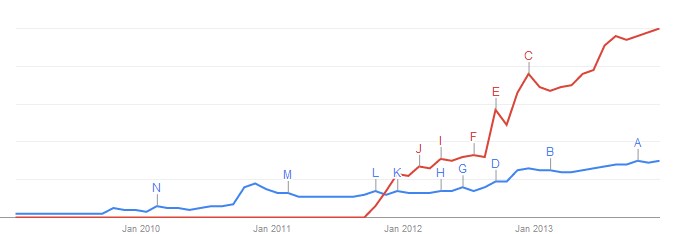Microsoft is set to close on a deal to purchase the vast majority of Nokia’s handset business in the first quarter of 2014. The deal will see the software giant become a smartphone OEM overnight, helping its push into the hardware business.
However, the choice to purchase Nokia’s Lumia line of smartphones may have been slightly less voluntary, and a bit more required than might have been previously thought.
More simply, Microsoft may have had little choice but to drop more than $7 billion on the deal.
Here’s a graph that shows search volume for Windows Phone (blue), and Lumia (red):

[The chart tracks global search volume on the Google search engine for each query, over time, on the same relative scale. As you can see, quickly following its launch, Lumia began to best Windows Phone, even though it is technically merely a participant in that platform. As time has progressed, its popularity has continued to beat Windows Phone’s, even as Windows Phone itself has become more popular.]
Given the rising disparity, Microsoft likely felt an increasing tension between its platform, and Nokia’s derivative brand. At what point does the student become the master, and so forth. The unpopularity of the Windows Phone moniker in fact led Matt Rossoff, then of Business Insider, to publicly call for Microsoft to rename the product.
On a relative basis, searches for Lumia outstrip queries for Windows Phone more than three to one.
Another point: Given that Nokia had become the de facto Windows Phone OEM, and had special permission to build handsets for that line with firmware changes and access to its own services, Microsoft had effectively lost control of the consumer experience of its mobile phones, something that was unacceptable, I presume.
And I bet Bing Maps didn’t relish the competition on its home-grown platform.
Hat Tip to Peter Bright for helping me get from my idea, to this idea.